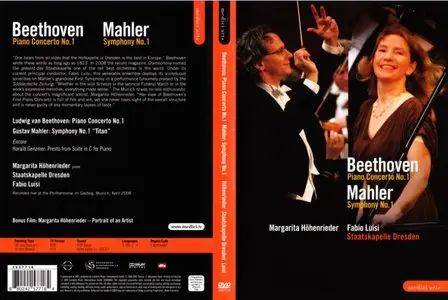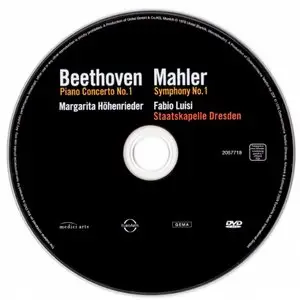Beethoven: Piano Concerto, No. 1 & Mahler: Symphony No. 1
DVD9 | ISO + Cover + Booklet | 7.2 GB
Classsical | Label: EuroArts | Release: 2009 | Catalog: 2057718 | RS&HF
DVD9 | ISO + Cover + Booklet | 7.2 GB
Classsical | Label: EuroArts | Release: 2009 | Catalog: 2057718 | RS&HF
Let me be honest: I got this for the Mahler, and it's excellent. I'll look at the Beethoven concerto some time down the road. But for me, this was my best encounter with the Mahler first in a long, long time. Even though I didn't agree with every interpretive decision that Fabio Luisi made, he knew exactly what he wanted, and exactly how to express what he wanted to the Dresdeners via his hands, eyes, and face. This guy is amazing.
As such, this is my third encounter with Luisi. The first two were the Bruckner 9th and Richard Strauss' "Alpine" symphony; both on Sony, and both of those are excellent. But then again, the Staatskapelle has had a long history with both Bruckner and Strauss. But I think this orchestra was also born to play the Mahler 1st. In fact, they've already made two very good commercial recordings of M1: one with Otmar Suitner in 1962 (sans expo repeat), and one with Hiroshi Wakasugi in 1986 (I own that one). However, both are now hard to find. I want to cover some specifics, so indulge me in some subjective blather first.
You see, Mahler 1 is basically two symphonies in one. First, there's the obvious stuff: the whooping horns and tricky timpani rhythms at the end of the first movement; the sherzo at full sail; the blustering brass and percussion at both ends of the finale. But then there's plenty of music that's a total opposite to all that: the woodwind fanfare figures near the start of the first movement (which get recapitulated in the finale); the "cozy to the point of sounding lazy" - yet totally playful - middle section of the scherzo; the beautiful "Lindenbaum" melody for soft strings and harps in the third movement; the gentle moments of refrain and reflection in the finale. These moments provide the greatest possible contrast to the music that one normally associates with Mahler: tons of brass and percussion. In this performance, the Staatskapelle cover both Mahlers thoroughly, and terrifically at that. Their strings, woodwinds, brass (not overbearing), and percussion - all four of these departments are excellent throughout the performance. Luisi focuses on these contrasts, and thus drives the point of this schism within the symphony. This is the youthful and impetuous Mahler, but fully capable of self reflection when called for. There are a pair of slightly controversial decisions on Luisi's part, and I may as well cover those now.
At the start of the slow movement, Luisi has the double bass solo - or what used to be considered a solo - played "soli" (the entire bass section). This is becoming more common now, as some evidence has surfaced for its justification. For me, this is a total non-issue, as I've never been a big fan of the "creeky" sounding solo bass anyway. It doesn't make that passage sound louder, just "smoother". Some may wince at that idea, but I find it less distracting. And the other choice I'm singling out will probably be more bothersome to a number of folks: in the slow movement, Luisi conducts the East European village band passages (they're brief), far faster than usual. Thus, once again, making a big contrast to the slow and soft music that surrounds it, and making those passages sound even more Klezmer-like than usual. It's different, and I wouldn't want to hear it done that way every time. But for a change, it was quite interesting, and worked quite well. By the way, in the final few bars of the finale, the timpani and bass drum rolls sound nice and fat - just as they should (and often times don't).
I'm beginning to ramble, so the bottom line is this: this is a terrific one-off of the Mahler first, captured on tour in the new concert hall in Munich (am Gasteig). As for the Beethoven first concerto, I'm sure it's fine too. The sound and picture are both excellent on this DVD, with good camera work decisions in the Mahler (very important!).
All that said, this DVD does face some pretty stiff competition, especially if you're wanting to own just one DVD of the Mahler 1st. First off, on DG, you can get Bernstein's highly idiomatic Mahler 1 (Vienna Phil.) coupled to a decent performance of Mahler 4, with Edith Mathis singing in the final movement. On Philips, you can get Bernard Haitink's far more straight-laced (poker faced, really) Mahler 1 with the Berlin Phil., coupled to an even better performance of Mahler's huge "Resurrection" symphony (#2). The picture and sound are better on the Haitink than on the Bernstein (it's far more recent), but not so the conducting. Either one of those will do just fine. I'm very happy with this Luisi/Dresden effort.
Now it's time for my gratuitous editorial jab: I find it interesting that Bernard Haitink chose to, more or less, reject the Staatskapelle Dresden. Based on the evidence of recent recordings, I would say that both the Staatskapelle, and Fabio Luisi (he looks a little like Roberto Benigni!), got the better end of that deal. Let's hope they come back in a few years time, and turn in an earthy yet exciting Mahler 3 (Abbado has fully covered the "heavenly" aspect).B. Guerrero – Amazon
Recorded Live at the Philharmonie im Gasteig, Munich, April 2008
Bonus Film: Margarita Höhenrieder - Portrait of an Artist
Runing Time: 107 min.(Concert) + 20 min (Bonus)
TV Format: DVD9 NTSC 16:9
Sound: PCM Stereo, Dolby Digital 5.1, DTS 5.1
Languages: D, GB, F, E
Region Code: 0 (worldwide)
Release Day: June 2009





